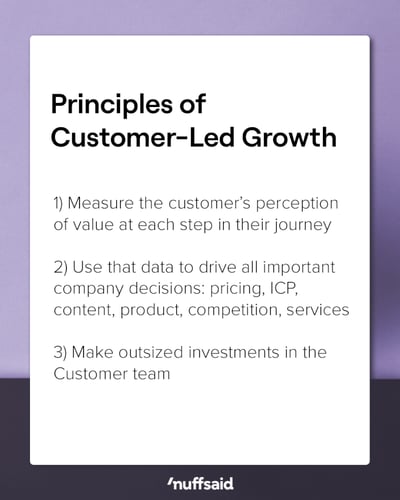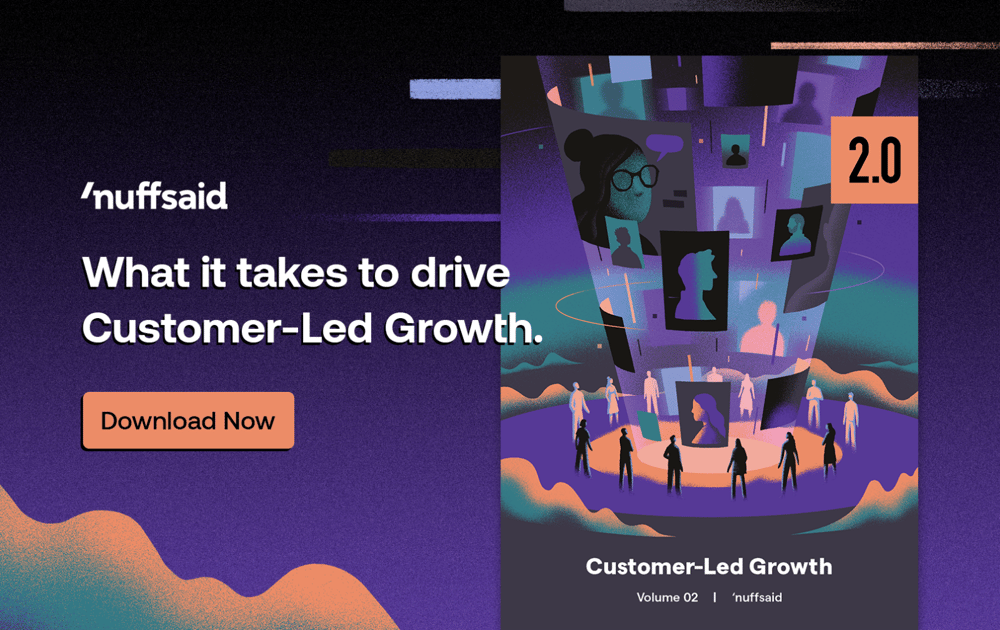This week we announced the release of the second issue of the 2.0 magazine, titled Customer-Led Growth. It’s an exploration of the teams, systems, and skills needed for Customer Success to drive a Customer-Led Growth model.
Customer-Led Growth is a term I expect we’ll begin to hear more often. That’s why this newsletter features the foreword from the new magazine, which outlines the principles of Customer-Led Growth.
But first: What is Customer-Led Growth?
Customer-Led Growth is an operating mode where everyone at the company is obsessed about the value customers are receiving from the product. And, you’ll read this below, it builds on the principles of Product-Led Growth.
And how did it come about?
First we have to start with the CEO. The CEO’s primary responsibility, in the eyes of their investors, is to increase the value of the company.
In the early days of SaaS, investors rewarded companies that grew very quickly, which created the Sales-Led growth approach where companies were willing to spend 100% or more of revenue to acquire new customers. These companies also tended to have high customer churn rates.
Then, when Wall Street saw how expensive it was to grow these companies, they started rewarding companies that could grow more efficiently. And from that emerged Product-Led Growth, a model where the value delivered from the product and network effects allowed companies to grow quickly with minimal Sales and Marketing investments. These companies also had much higher customer retention rates.
But here’s the rub: 95% of companies will never be Product-Led. That’s because they’re missing the key ingredients that enable PLG, the most important one being that the product has to be very simple to use, and also the customer has to get high value with minimal effort. Very few companies have a product like that.
So if 95% of companies will never be Product-Led, but investors still want low-cost growth and high retention rates, another model is needed. That’s where Customer-Led Growth comes in.
By obsessing about the value customers receive, it forces the company to achieve product-market fit. Great product-market fit leads to great retention rates, great customer advocacy, and much lower costs to grow revenue than traditional Sales-Led Growth models.
Below you’ll find the foreword from the new magazine, which outlines the principles of CLG.

“Design for users!”
“Deliver value without friction!”
“Monetize upgrades that deliver more value!”
Read those declarations aloud, and your brain probably will go to Product-Led Growth. That’s because those ideas are core to the increasingly popular PLG model, and have helped companies like Slack, Zoom, and Airtable skyrocket their growth.
The principles of PLG power a very small percentage of companies. Most companies, which aren’t a good fit for PLG, latch onto the trend by putting a free trial on their website… And it doesn’t produce the results they’d expect.
That’s because most companies don’t have the core ingredients to enable PLG:
- A very simple-to-use product
- Each user receives benefit when the product is shared with others
- The product allows users to get high value with little effort
Companies that don’t meet all 3 of PLG’s criteria won’t be able to pull off Product-Led Growth. However, the principles of PLG are still solid. They can be built on to apply to customers who aren’t a good fit for the PLG model.
That’s where Customer-Led Growth comes in. Customer-Led Growth builds on the principles of Product-Led Growth and acknowledges that 95% of companies will never be able to truly be Product-led.
In a CLG model, the entire company obsesses about the value that customers are receiving.
- The company measures whether or not the customer has received value (was the planned outcome achieved, and does the customer believe they received value),
- They use customer data to drive pricing, target market research, the content roadmap, and product decisions,
- And they make outsized investments in their Customer team.

In a CLG company, the Customer executive is one of the most important members of the executive team. They own “customer value” on behalf of the company, and arm their peers with the data that’s needed to acquire the right customers, with the right use cases, at the right price point, with the right features, to ensure the company maximizes its growth rate and profitability over time.
So for this issue, we explore the team, systems, and executive skills a Customer Success function needs to lead a Customer-Led Growth model. From unlocking CS Ops and designing digitally-led programs, to influencing Product, Marketing, and Sales — we hope this issue serves as a reminder that CLG is a company-wide job, and inspires Customer Success leaders to lead the charge.

The best resources for Customer Success teams this week
PROCESS
QBRs Are Stupid
In the past 2 days both Aaron Thompson and Nick Mehta have called for a change to how most CS teams run QBRs. Nick’s post is tactical and Aaron’s takes a higher-level view at what makes QBRs ineffective (or his words: “stupid”). Consider using both to do an audit with your team.
LEADERSHIP
A Leader’s Job Is to Create Clarity on the Problems to Be Solved
Segment’s CEO Peter Reinhardt reflects on an experience at Segment (“everything was burning”), and explains why the solution was to share what the company’s problems were and let the team solve them. This lesson is easier said than done and it’s not the default way of working for many people. A helpful reminder.
MONETIZING CS
5 Models for Monetizing Customer Success
Marley Wagner discusses potential pathways for monetizing the CS motion. This piece might be a useful starting point for any leader thinking about implementing new CS models.
CAREER
Extending Your Personal Runway
Here’s a thoughtful examination by executive coach, Ed Batista, on how to assess a difficult professional transition. “Senior leaders do enjoy many advantages: They're well-compensated, have a great deal of autonomy, and often feel a strong sense of purpose. But such roles also come with significant downsides… [they] the subject of intense scrutiny, receive little developmental feedback, and are rarely viewed empathetically by others. So despite the many benefits of these roles, feelings of stress, fatigue and isolation can cause senior leaders to entertain thoughts of leaving.”

Success Happy Hour is a weekly newsletter for Customer Success leaders. Each week we feature one digestible piece of advice or a framework from a top Success leader, along with the best resources from that week. Subscribe here.


Submit a comment